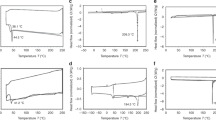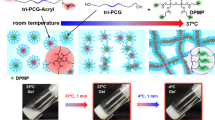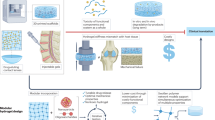Abstract
Controlled-release drug delivery systems have many applications, including treatments for hormone deficiencies and chronic pain. A biodegradable device that could provide multi-dose drug delivery would be advantageous for long-term treatment of conditions requiring pulsatile drug release. In this work, biodegradable polymeric microchips were fabricated that released four pulses of radiolabelled dextran, human growth hormone or heparin in vitro. Heparin that was released over 142 days retained on average 96 ± 12% of its bioactivity. The microchips were 1.2 cm in diameter, 480–560 μm thick and had 36 reservoirs that could each be filled with a different chemical. The devices were fabricated from poly(L-lactic acid) and had poly(D,L-lactic-co-glycolic acid) membranes of different molecular masses covering the reservoirs. A drug delivery system can be designed with the potential to release pulses of different drugs at intervals after implantation in a patient by using different molecular masses or materials for the membrane.
This is a preview of subscription content, access via your institution
Access options
Subscribe to this journal
Receive 12 print issues and online access
$259.00 per year
only $21.58 per issue
Buy this article
- Purchase on Springer Link
- Instant access to full article PDF
Prices may be subject to local taxes which are calculated during checkout





Similar content being viewed by others
References
Bakken, E.E. & Heruth, K. Temporal control of drugs: an engineering perspective. Ann. N.Y. Acad. Sci. 618, 422–427 (1991).
Langer, R. New methods of drug delivery. Science 249, 1527–1533 (1990).
Matthews, D.R., Lang, D.A., Burnett, M.A. & Turner, R.C. Control of pulsatile insulin secretion in man. Diabetologia 24, 231–237 (1983).
Santini, J.T. Jr, Richards, A.C., Scheidt, R., Cima, M.J. & Langer, R. Microchips as controlled drug-delivery devices. Angew. Chem. Int. Edn 39, 2396–2407 (2000).
Wu, B.M. et al. Solid free-from fabrication of drug delivery devices. J. Control. Release 40, 77–87 (1996).
Katstra, W.E. et al. Oral dosage forms fabricated by Three Dimensional Printing™. J. Control. Release 66, 1–9 (2000).
Rowe, C.W. et al. Multimechanism oral dosage forms fabricated by Three Dimensional Printing™. J. Control. Release 66, 11–17 (2000).
Santoro, N. Efficacy and safety of intravenous pulsatile gonadotropin-releasing hormone: Lutrepulse for injection. Am. J. Obstet. Gynecol. 163, 1759–1764 (1990).
Creasy, G.W. & Jaffe, M.E. Pulsatile delivery systems. Ann. N.Y. Acad. Sci. 618, 548–557 (1991).
Creasy, G.W. & Jaffe, M.E. Endocrine/reproductive pulsatile delivery systems. Adv. Drug Deliv. Rev. 6, 51–56 (1991).
Sampath, P. & Brem, H. Implantable slow-release chemotherapeutic polymers for the treatment of malignant brain tumors. J. Moffitt Cancer Center 5, 130–137 (1998).
Murray, L. (ed.) Physicians' Desk Reference 57th edn (Thomson PDR, Montvale, New Jersey, 2003).
Brown, L. & Langer, R. Transdermal delivery of drugs. Annu. Rev. Med. 39, 221–229 (1988).
Sershen, S. & West, J. Implantable, polymeric systems for modulated drug delivery. Adv. Drug Deliv. Rev. 54, 1225–1235 (2002).
Siegel, R.A., Falamarzian, M., Firestone, B.A. & Moxley, B.C. pH-controlled release from hydrophobic/polyelectrolyte copolymer hydrogels. J. Control. Release 8, 179–182 (1988).
Kim, J.H., Kim, J.Y., Lee, Y.M. & Kim, K.Y.J. Controlled release of riboflavin and insulin through crosslinked poly(vinyl alcohol)/chitosan blend membrane. Appl. Polym. Sci. 44, 1923–1828 (1992).
Gutowska, A. et al. Squeezing hydrogels for controlled oral drug delivery. J. Control. Release 48, 141–148 (1997).
Bae, Y.H., Okano, T., Hsu, R. & Kim, S.W. Thermo-sensitive polymers as on-off switches for drug release. Makromol. Chem., Rapid Commun. 8, 481–485 (1987).
Hoffman, A.S., Afrassiabi, A. & Dong, L.C. Thermally reversible hydrogels. II. delivery and selective removal of substances from aqueous solutions. J. Control. Release 4, 213–222 (1986).
Okano, T., Bae, Y.H. & Kim, S.W. in Pulsed and Self-Regulated Drug Delivery (ed. Kost, J.) 17–45 (CRC Press, Boca Raton, Florida, 1990).
Kost, J. & Langer, R. in Pulsed and Self-Regulated Drug Delivery (ed. Kost, J.) 3–16 (CRC Press, Boca Raton, Florida, 1990).
Kost, J., Leong, K. & Langer, R. Ultrasound-enhanced polymer degradation and release of incorporated substances. Proc. Natl Acad. Sci. USA 86, 7663–7666 (1989).
Fischel-Ghodsian, F., Brown, L., Mathiowitz, E., Brandenburg, D. & Langer, R. Enzymatically controlled drug delivery. Proc. Natl Acad. Sci. USA 85, 2403–2406 (1988).
Mathiowitz, E. & Cohen, M.D. Polyamide microcapsules for controlled release. V. photochemical release. J. Membr. Sci. 40, 67–86 (1989).
Kwon, I.C., Bae, Y.H. & Kim, S.W. Electrically erodible polymer gel for controlled release of drugs. Nature 354, 291–293 (1991).
Bae, Y.H., Kwon, I.C. & Kim, S.W. in Polymeric Drugs and Drug Administration (ed. Ottenbrite, R.M.) 98–110 (American Chemical Society, Washington, DC, 1994).
Miller, L.L. Electrochemically controlled release of drug ions from conducting polymers. Mol. Cryst. Liq. Cryst. 160, 297–301 (1998).
Hepel, M. & Fijalek, Z. in Polymeric Drugs and Drug Administration (ed. Ottenbrite, R.M.) 79–97 (American Chemical Society, Washington, DC, 1994).
Schwendeman, S.F., Amidon, G.L. & Levy, R.J. Determinants of the modulated release of antiarrhythmic drugs by iontophoresis through polymer membranes. Macromolecules 26, 2264–2272 (1993).
Edelman, E.R., Kost, J., Bobeck, H. & Langer, R. Regulation of drug release from polymer matrices by oscillating magnetic fields. J. Biomed. Mater. Res. 19, 67–83 (1985).
Suzuki, Y. et al. A new drug delivery system with controlled release of antibiotic only in the presence of infection. J. Biomed. Mater. Res. 42, 112–116 (1998).
Santini, J.T. Jr, Cima, M.J. & Langer, R. A controlled-release microchip. Nature 397, 335–338 (1999).
Jiang, H.L. & Zhu, K.J. Pulsatile protein release from a laminated device comprising of polyanhydrides and pH-sensitive complexes. Int. J. Pharm. 194, 51–60 (2000).
Qiu, L.Y. & Zhu, K.J. Design of a core-shelled polymer cylinder for potential programmable drug delivery. Int. J. Pharm. 219, 151–160 (2001).
Göpferich, A. Bioerodible implants with programmable drug release. J. Control. Release 44, 271–281 (1997).
Kikuchi, A., Kawabuchi, M., Sugihara, M., Sakurai, Y. & Okano, T. Pulsed dextran release from calcium-alginate beads. J. Control. Release 47, 21–29 (1997).
Misra, G.P. & Siegel, R.A. New mode of drug delivery: long term autonomous rhythmic hormone release across a hydrogel membrane. J. Control. Release 81, 1–6 (2002).
Lu, L., Garcia, C.A. & Mikos, A. In vitro degradation of thin poly(DL-lactic-co-glycolic acid) films. J. Biomed. Mater. Res. 46, 236–244 (1999).
Anderson, J.M. & Shive, M.S. Biodegradation and biocompatibility of PLA and PLGA microspheres. Adv. Drug Deliv. Rev. 28, 5–24 (1997).
Grizzi, I., Garreau, H., Li, S. & Vert, M. Hydrolytic degradation of devices based on poly(DL-lactic acid) size-dependence. Biomaterials 16, 305–311 (1995).
Tamada, J.A. & Langer, R. Erosion kinetics of hydrolytically degradable polymers. Proc. Natl Acad. Sci. USA 90, 552–556 (1993).
Gilding, D.K. & Reed, A.M. Biodegradable polymers for use in surgery—polyglycolic/poly(lactic acid) homo- and copolymers: 1. Polymer 20, 1459–1464 (1979).
Kulkarni, R.K., Moore, E.G., Hegyeli, A.F. & Leonard, F. Biodegradable poly(lactic acid) polymers. J. Biomed. Mater. Res. 5, 169–181 (1971).
Göpferich, A. Mechanisms of polymer degradation and erosion. Biomaterials 17, 103–114 (1996).
Miller, R.A., Brady, J.M. & Cutright, D.E. Degradation rates of oral resorbable implants (polylactates and polyglycolates): rate modification with changes in PLA/PGA copolymer ratios. J. Biomed. Mater. Res. 11, 711–719 (1977).
Vert, M., Mauduit, J. & Li, S. Biodegradation of PLA/GA polymers: increasing complexity. Biomaterials 15, 1209–1213 (1994).
Vert, M., Li, S.M. & Garreau, H. Attempts to map the structure and degradation characteristics of aliphatic polyesters derived from lactic and glycolic acids. J. Biomater. Sci. Polym. Edn 6, 639–649 (1994).
Jandik, K.A., Kruep, D., Cartier, M. & Linhardt, R.J. Accelerated stability studies of heparin. J. Pharm. Sci. 85, 45–51 (1996).
Shawgo, R.S., Grayson, A.C.R., Li, Y. & Cima, M.J. BioMEMS for drug delivery. Curr. Opin. Solid State Mater. Sci. 6, 329–334 (2002).
Acknowledgements
This work was supported by the National Institutes of Health Bioengineering Research Partnership grant R24-AI47739-02. A.C.R.G. thanks the American Association of University Women and the National Science Foundation for fellowship funding. I.S.C. thanks the Korea Science and Engineering Foundation and the Brain Korea 21 project.
Author information
Authors and Affiliations
Corresponding author
Ethics declarations
Competing interests
The technology reported in our manuscript (a polymeric microchip for molecular delivery) is licensed to MicroCHIPS, Inc., of Bedford, Massachusetts. Amy Grayson, Michael Cima and Robert Langer are shareholders in MicroCHIPS, Inc.
Supplementary information
Rights and permissions
About this article
Cite this article
Grayson, A., Choi, I., Tyler, B. et al. Multi-pulse drug delivery from a resorbable polymeric microchip device. Nature Mater 2, 767–772 (2003). https://doi.org/10.1038/nmat998
Received:
Accepted:
Published:
Issue Date:
DOI: https://doi.org/10.1038/nmat998
This article is cited by
-
Prospective pathways of green graphene-based lab-on-chip devices: the pursuit toward sustainability
Microchimica Acta (2022)
-
Wireless on-demand drug delivery
Nature Electronics (2021)
-
Transdermal microneedles for the programmable burst release of multiple vaccine payloads
Nature Biomedical Engineering (2020)
-
The extremal pentagon-chain polymers with respect to permanental sum
Scientific Reports (2020)
-
Preparation of isometric Liesegang patterns and application in multi-pulsed drug release system
Journal of Sol-Gel Science and Technology (2019)



